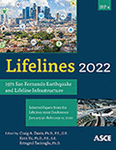Seismic Reliability Assessment of Buried Pipelines Subjected to Significant Permanent Ground Deformations in an M9 Cascadia Subduction Zone Earthquake
Publication: Lifelines 2022
ABSTRACT
Pipelines in regions with moderate and high seismic hazard may be at risk of structural damage and service disruption due to permanent ground deformations (PGD), including earthquake-triggered landslides and liquefaction-induced lateral spread and settlement. Efficient methods of reliability assessment may be required when finite element soil-structure interaction and detailed fragility-based analyses are not possible. This study presents such methods based on a seismic reliability assessment study of large diameter buried pipelines as part of a comprehensive water system seismic study for the Portland Water Bureau (Portland, Oregon). The target audience for this study is engineers as well as water system owners and operators. A case study is presented of three approximately 20 mile long steel pipelines ranging in size from 44 to 66 in. that transport water to East Portland from the Bull Run watershed, and five Willamette River crossings that transport water from East to West Portland. The river crossings include 30 to 60-in. diameter buried pipelines of material types ranging from cast iron and ductile iron to welded steel and bar-wrapped concrete cylinder pipes with welded joints. Segments of these pipelines are subject to as much as 10 ft of combined landslide and lateral spread permanent ground deformations for an M9 scenario earthquake on the Cascadia Subduction Zone. The locations, widths, and magnitudes of the PGD demands on the pipelines were calculated in a GIS framework at the intersection of the pipelines with locations susceptible to landslides and liquefaction. Using available information on the pipeline size, internal pressure, and nominal wall thickness, a simplified analytical analysis was performed to compute maximum strains in the pipelines resulting from transverse PGD. Analytical analysis results were confirmed using nonlinear finite element analyses for representative pipeline segments. Uncertainties in the PGD estimates, width of PGD zones, analytical procedures, and peak ground acceleration were used to perform Monte Carlo simulations to compute individual and joint failure probabilities for the pipelines. Reasonable parameter distributions and values for the analytical pipeline strain and Monte Carlo simulation analyses are provided. The methodology presented in this study uses analytical procedures to assess pipeline vulnerability and provides likely locations of damage compared to more general evaluations typically performed using empirical pipeline fragilities. This approach can be used by engineers performing similar studies to better quantify pipeline vulnerability and provide a more realistic assessment to the owners.
Get full access to this article
View all available purchase options and get full access to this chapter.
REFERENCES
ALA (American Lifelines Alliance). 2001. “Seismic Fragility Formulations for Water Systems”, www.americanlifelinesalliance.org, April.
ALA (American Lifelines Alliance). 2005. “Seismic Guidelines for Water Pipelines”, www.americanlifelinesalliance.org, March.
ASCE. “Minimum Design Loads for Buildings and Other Structures.”, ASCE, Reston, VA., 473 p. 1984.
ANSYS Release 11.0, ANSYS Inc., Southpointe, 275 Technology Drive, Canonsburg, PA 15317, www.ansys.com.
Boore, D. M., and Atkinson, G. 2008. Ground Motion Prediction Equations for the Average Horizontal Component of PGA, PGV, and 5%-damped PSA at Spectral Periods between 0.01 and 10.0 s, Earthquake Spectra, Vol. 24, No.1.
DOGAMI. 2013., Ground motion, ground deformation, tsunami inundation, coseismic subsidence, and damage potential maps for the 2012 Oregon Resilience Plan for Cascadia Subduction Zone Earthquakes, by Ian P. Madin and William J Burns, Oregon Department of Geology and Mineral Industries, 800 NE Oregon Street #28, Suite 965, Portland, Oregon 97232-21622.
O’Rourke, T. D., Jeon, S., Toprak, S., Cubrinovski, M., Hughes, M., Ballegooy, S., and Bouziou, D. Earthquake Response of Underground Pipeline Networks in Christchurch, NZ. Earthquake Spectra: Vol. 30, No. 1, pp. 183-204 February 2014.
O’Rourke, M. J., and Liu, X. J. 2012. Seismic Design of Buried and Offshore Pipelines,.
OSSPAC (Oregon Seismic Safety Policy Advisory Commission). The Oregon Resilience Plan, Reducing Risk and Improving Recovery for the Next Cascadia Earthquake and Tsunami Report to the 77th Legislative Assembly, Salem, Oregon, February 2013.
PRCI (Pipeline Research Council International), Honegger, D. G., and Nyman, D. 2004. PRCI Guidelines for the Seismic Design and Assessment of Natural Gas and Liquid Hydrocarbon Pipelines, Pipeline Research Council International, published by Technical Toolboxes, Houston, Texas.
Information & Authors
Information
Published In
History
Published online: Nov 16, 2022
Authors
Metrics & Citations
Metrics
Citations
Download citation
If you have the appropriate software installed, you can download article citation data to the citation manager of your choice. Simply select your manager software from the list below and click Download.
